#Adirondack Forest Preserve
Explore tagged Tumblr posts
Video
Adirondacks 360 Degree aerial view by Daniel Piraino Via Flickr: Captured in the Adirondacks 09/10/2024
#360 Aerial Photography#360degree#360imagery#aerialview360#360 aerial#Adirondacks#Adirondack#adirondack aerial images#Adirondack Forest Preserve#Adirondack Park#flickr
0 notes
Text
0 notes
Text
The Olympics Have A Dirty History—Literally! But A Green Sports Movement Is Pushing For Change, Eager To See If Paris Will Be Different.
— July 20, 2024 | By Madeleine Orr, University of Toronto | Foreign Policy

The wind blows a plastic bag past the National Stadium, also known as the Bird's Nest, in Beijing on January 23, 2008. Guang Niu/Getty Images
In April 1929, the International Olympic Committee (IOC) met in Lausanne, Switzerland, to grant the hosting rights for the 1932 Winter Olympic Games. The United States was the frontrunner, and seven U.S. candidate sites showed up to bid: Bear Mountain and Lake Placid, New York; Denver, Colorado; Duluth, Minnesota; Minneapolis, Minnesota; and Lake Tahoe and Yosemite Valley, California. For many small mountain towns, this would be their shot to generate the investment dollars needed to build new winter sport infrastructure and secure a strong tourism industry in a very economically fragile time—the start of the Great Depression.

This article is adapted from Warming Up: How Climate Change Is Changing Sport by Madeleine Orr (Bloomsbury, 320 pp., $25.20, May 2024).
Godfrey Dewey, vice president of the exclusive Lake Placid Club (and son of the inventor of the Dewey Decimal Classification System for library books) was the lead administrator of the town’s bid. Dewey made a series of lofty promises—chief among them, a new Olympic sliding track for bobsled. Then-New York Gov. (and later U.S. president) Franklin D. Roosevelt wrote letters in support of the project, turning the small New York town into a frontrunner.
It all seemed promising, until Lake Placid secured hosting rights and things got messy.
Dewey’s planned bobsled run was to be on the Lake Placid Club’s site, within the protected Adirondack Forest Preserve. The Association for the Protection of the Adirondacks led a legal complaint in New York State courts, claiming that the project went against the “forever wild” clause of the state’s constitution, which maintains that state lands “constituting the forest preserve…shall be forever kept as wild forest lands.”

The U.S. four-man bobsleigh team shoots a curve on the run at Lake Placid, New York, on February 16, 1932. Bettmann Archive/Getty Images
A two-year legal battle ensued. Environmental activists routinely protested and made noise in the press. Eventually, the New York State Court of Appeals held that a statute authorizing the construction of a bobsled run, requiring the destruction of 5,122 trees, was unconstitutional. Dewey and the organizing committee were forced to find a location elsewhere. They settled on a site just outside the Forest Preserve boundary.
That kind of pressure from environmental groups has never gone away. In nearly every Olympic host city since, there has been what sport sociologist Jules Boykoff calls the “NOlympic movement”—organized groups of people who do not want these large, damaging events to come to town. Over time, these movements gained momentum and media attention, eventually reaching Olympic decision-makers and creating public pressure to effect positive green change. But this process would take decades.

A lone celebrant views a tally board at the Denver Olympic Committee victory headquarters in Colorado on November 7, 1972, after voters rejected funding of the 1976 Winter Olympics. Bettmann Archive/Getty Images
Fast forward to 1970. Denver was awarded the hosting rights for the 1976 Winter Olympics. It was billed as an ideal opportunity to celebrate the United States’ bicentennial and Colorado’s centennial anniversaries. But it took less than a year for the Games to be met with major dissent from local politicians. Months after the hosting rights were awarded to the city, State Rep. Bob Jackson told the Associated Press, “We ought to say to the nation and the world, ‘We’re sorry, we are concerned about the environment. We made a mistake. Take the Games elsewhere.’”
Dick Lamm, another state representative, told Ski Magazine, “Every time I ask a question about ecology, the Olympic people tell me, ‘Don’t worry, we are going to take care of that.’ But a state which has never taken down as much as a single billboard to improve the environment is not going to run an Olympics which the ecologists would like.” By 1972, the city withdrew from hosting and the Games were moved to Innsbruck, Austria, which had held the event in 1964 and had most facilities ready to go.
Germany also saw environmental groups put pressure on—and ultimately shut down—the Olympics over environmental concerns. In 1983, the mayor and local tourism director of Berchtesgaden announced a bid for the 1992 Winter Olympics. Almost immediately, a local citizens’ initiative was organized against it, and successfully campaigned to shut down the bid. That edition of the Winter Games was hosted by Albertville, France.
Amanda Shuman, a historian at the University of Freiburg, has been studying how the Berchtesgaden citizens’ initiative was contextually different from those that preceded it in other countries. She and I work together through the Sport Ecology Group, so I called her to get the background story.
“The early 1980s were a unique time for the environmental movement in Germany. Acid rain was at the top of everyone’s mind because Der Spiegel, the country’s biggest magazine, decided to run a series of exposés on forest death with pretty aggressive headlines like ‘The Forest is Dying,’” Shuman said. “At the same time, the newly formed Green Party rode that wave of public concern into their first seats in Parliament. Environmental groups watched this happen and were emboldened to act on different issues because there was more visibility and political support for their work.”
Shuman argues that historically, anti-sport development efforts went against the political grain, as politicians routinely used sporting mega-events as a platform-building opportunity. But in 1970s Colorado, and again in 1980s Germany, there was some degree of political support behind anti-Olympics campaigns.

The opening ceremony of the Lillehammer Winter Olympics in Norway on February 12, 1994. Pascal Rondeau/AllSport/Getty Images
Despite repeated involvement and pressure by environmental groups to slow, move, or shut down sport development and big events through the 20th century, it wasn’t until the 1990s that sports organizations took up the mantle of environmental action themselves.
In 1992, the same year that the word “sustainability” entered the global lexicon at the United Nations Earth Summit in Brazil, the IOC was facing challenges with the perceptions of the Olympics following the Albertville Winter Games, which were dubbed an “environmental catastrophe” in the local news given the extraordinary distance between the different venues. The event was so spread out geographically that athletes and spectators drove through the mountains from one town to the next, clogging up the roadways and polluting an otherwise quiet area of France.
After Albertville, the IOC knew it had to act to strengthen its reputation on environmental issues and align more closely with growing global concerns about the climate. It’s still not clear whether the IOC has succeeded at improving its record or reputation on environmental work.
The 1994 Winter Olympics in Lillehammer, Norway, are viewed as the first attempt to create a “green” Olympic Games. It was a tall order. After the environmental wreckage at Albertville, local activists in Lillehammer forced the organizing committee to adapt their hosting plans based on environmental concerns. The changes included a redesigned speed-skating rink that minimized impacts on a nearby bird sanctuary, a plan to prioritize the use of renewable building materials, energy-efficiency upgrades for facilities, and a recycling program at all venues.
The 1990s were a supercharged decade for sustainability across all sports, not just the Olympic Games. In 1993, the National Football League in the United States launched their NFL Green campaign, which has seen every subsequent Super Bowl implement waste management and nature restoration projects. In 1994, the United Nations Environment Program (UNEP) created its Sports and Environment Program to promote environmental awareness through sports and sustainable design principles in sports facilities and equipment manufacturing. Also that year, the Centennial Olympic Congress of Paris named the environment a “third pillar” of the Olympic charter, alongside sport and culture.
Later in the 1990s, the UNEP worked with the IOC to develop an “Agenda 21” for the Olympic Movement based on sustainability guidelines created by delegates at the 1992 Earth Summit in Rio. (The document’s publication was sponsored by Shell.) The IOC committed itself to promoting sustainability among its 206 member nations and 30 governing bodies for winter and summer sports, and to require sustainability plans from the hosts of its marquee events. This is only a commitment to “encourage” sustainability, though, not to mandate it. The IOC does not control operations among its members. Despite these ambitions, the process of implementation has been a roller-coaster, with several sharp turns off-course.
For the first 20 years of the green sports movement, from about 1992 to 2012, the focus was on operational improvements: reducing waste, switching to energy-efficient lighting, using less water, and measuring carbon footprints. These efforts were impactful. Consider how much toilet paper is used in a stadium with hundreds of toilets—it’s a lot. Finding a toilet paper provider that uses recycled paper instead of fresh forests is a meaningful improvement.

The washroom inside the National Aquatics Center, where swimming, diving, and synchronized swimming Olympic events were held, in Beijing on January 28, 2008. Feng Li/Getty Images
Or think about the water savings that can be achieved by implementing an irrigation system that cuts water use from 60,000 liters per night to 50,000. In one year, the facility will reduce its water consumption by more than 4.1 million liters. That’s enough water to fill three Olympic-size swimming pools. But these efforts can be hard to communicate to fans and do little to leverage sports’ sizeable platform to inspire fans to act on climate change and build popular support for action.
A 2021 study published by Martin Müller and colleagues at the University of Lausanne developed a model to evaluate the environmental sustainability of Olympic Games hosted between 1992 and 2020. It found that Salt Lake City in 2002 was the most sustainable, while more recent iterations in Sochi, Russia, in 2014 and Rio de Janeiro in 2016 were the least sustainable. Part of the challenge for the IOC is that each host country is operating within its own sets of definitions, limitations, and government priorities, so sustainability often takes a back seat to tourism development and growth plans.

Cyclists ride over a road sign demarcating a Paris 2024 bike lane along the Rue de Rivoli in Paris on July 3. Julien De Rosa/AFP Via Getty Images
Some of the Most Exciting Work on Sustainability is Coming Out of the Paris 2024 Olympic Committee, which promises a carbon-positive Games. The French capital has banned non-essential through traffic from its city center effective in 2024, making 5.4 square miles of the city straddling both sides of the Seine much greener and cleaner. They are also adding bike lanes and bus routes, and 95 percent of the venues will be existing facilities or temporary builds, so only two new builds are needed. We haven’t seen anything better than this. Still, there will be loads of tourists (it’s Paris, there are always tourists), so the organizers have committed to offsetting all remaining emissions.
I have been outspoken in recent years about how I don’t think it’s possible to have a carbon-positive Olympic Games—and that this language is misleading and potentially detrimental to the broader movement. It’s great to see the ambition to be very low-impact, but “carbon-positive” is just not realistic in the context of an international sporting event with hundreds of thousands of tourists and participants.
Overall, though, the green sports movement is decidedly on the right track. Reflecting on the progress to date in the United States, environmental scientist Allen Hershkowitz—once dubbed the “Godfather of Green Sports”—said in a podcast interview in 2021, “I think, actually, over the last 10 years, the sport and sustainability movement has been one of the most effective sectors in the environmental advocacy world, especially in North America, where our government has been outright hostile to environmental progress.”
From where I’m standing, it’s clear a lot more has been happening in green sports in recent years. The sector is moving forward, and moving together. Now we have to pick up the pace.
— Madeleine Orr is an Assistant Professor of Sport Ecology at the University of Toronto. She is the Founder of the Sport Ecology Group and the Author of the recent book Warming Up: How Climate Change is Changing Sport.
#Foreign Policy#Olympics#Dirty History#Green Sports Movement#Paris Olympics#Madeleine Orr | Assistant Professor | Sport Ecology | University of Toronto | Canada 🇨🇦 🍁#Warming Up: How Climate Change is Changing Sport
0 notes
Text
Wild at Heart - Joshua Vandervoort New York's Love for Nature and Conservation Efforts
The Man Behind the Conservation: Exploring Joshua Vandervoort's Passion for New York's Wilderness
Among these individuals is Joshua Vandervoort New York, an environmental stalwart who encapsulates the deep-rooted connection between man and nature. Born and raised in Rochester, New York, Joshua has cultivated a fervent love for nature and a commitment to its preservation for future generations. His affinity for the wilderness and the serene waterways of Western New York is not only a testament to his personal joy and fulfillment but also an inspiration for his dedication towards environmental stewardship. Joshua's childhood was spent hiking the hills of the Southern Tier region on his family's land and exploring the tranquil beauty of the Finger Lakes through fishing and sailing.
These formative experiences, under the guiding influence of his family, were instrumental in shaping his drive to be a steward of the land. Even during his busy professional life, Joshua continues to spend his free time in communion with nature, whether through further explorations of the water in his fishing boat or backpacking the stunning landscapes of the Adirondack and Catskill mountains. This enduring love for nature, and the conscious efforts made to preserve it, highlights the importance of the bond between man and nature; a bond that is not just about co-existence, but about active participation and contribution towards sustainable cohabitation.
The Love Affair with Nature: A Lifelong Romance
For many men, the love for nature is a lifelong affair that often begins during childhood. Whether it's exploring the woods, fishing in a serene lake, or simply gazing at the stars in the night sky, these early encounters with the natural world leave an indelible mark. This fascination with nature, often rooted in curiosity and wonder, evolves into a profound love as one grows older.
For individuals like Joshua Vandervoort New York, as they journey through the stages of adulthood, the whisper of nature's untamed beauty often intensifies into an irresistible call. This call can take myriad forms, resonating deeply within the soul, and compelling them to venture into the wilderness. Whether it's the thrill of embarking on adrenaline-fueled hiking expeditions, the tranquility found in the quiet observation of avian life, or the zen-like focus required by an avid angler waiting for that decisive tug on the fishing line. The allure of nature becomes an undeniable force.
It's in these moments of communion with nature that a man's love for the environment truly flourishes. The solitude and serenity of a forest, the majesty of a mountain peak, or the tranquility of a secluded beach all have the power to rejuvenate the soul and reinforce the bond between man and the natural world. Josh Vandervoort
As this love for nature deepens, it naturally leads to a sense of responsibility for its preservation. Joshua Vandervoort New York’s love for the environment often evolves into a commitment to conservation efforts. This sense of stewardship arises from the understanding that the beauty and biodiversity of our planet are fragile and in need of protection.
Conservation efforts can take many forms. Some men become advocates for the environment, using their voices and influence to raise awareness about critical issues such as deforestation, climate change, and endangered species. Others become actively involved in restoration projects, reforestation initiatives, or wildlife rehabilitation programs.
One of the most potent ways a man's love for nature translates into meaningful conservation efforts is through education and outreach. Sharing knowledge and fostering a love for the environment in the younger generation is crucial for the long-term preservation of our planet.
Many men who are passionate about nature engage in teaching, mentoring, or volunteering in environmental education programs. These programs not only instill a sense of wonder and respect for the natural world in young minds but also empower them with the knowledge and tools to become future conservationists. Moreover, in today's digital age, social media platforms and online communities provide a powerful platform for men to share their love for nature and conservation efforts with a global audience. By leveraging these platforms, individuals can inspire and mobilize others to join the cause. Josh Vandervoort Rochester New York
The Collective Impact of Men's Conservation Efforts
Joshua Vandervoort New York's love for nature and his conservation efforts, while they may seem like drops in the vast ocean of environmental challenges, have a profound impact. When men like Joshua, from all walks of life, come together with a shared passion for preserving the environment, they create a formidable force for positive change.
Conservation organizations, both large and small, often benefit greatly from the dedication of men who contribute their time, resources, and expertise. Whether it's funding research projects, participating in conservation expeditions, or simply spreading awareness, the involvement of men is instrumental in advancing the cause of environmental conservation.
Celebrating Men's Love for Nature and Conservation Efforts
In a world that often emphasizes urbanization and technological progress, it's crucial to recognize and celebrate the enduring love that many men have for nature. This love is a source of inspiration, driving them to become stewards of the environment and champions of conservation.
The call of the wild, the sense of responsibility, and the commitment to education and outreach are all facets of Joshua Vandervoort New York’s love for nature that fueled his conservation efforts. When men unite their passions and dedicate themselves to preserving the natural world, they create a brighter future for our planet and all its inhabitants.
Taking the example of Joshua Vandervoort New York, a place imbued with incredible natural beauty, serves to remind us of the profound connection between man and nature. The onus of conservation is not a solo journey but a shared duty. By recognizing and valuing the passion individuals like Joshua have for the environment, we can foster a deeper admiration for the splendor of our world and motivate future generations to participate in the continuing endeavor to safeguard and preserve it.
0 notes
Text
Popular Hiking Destinations in New York State
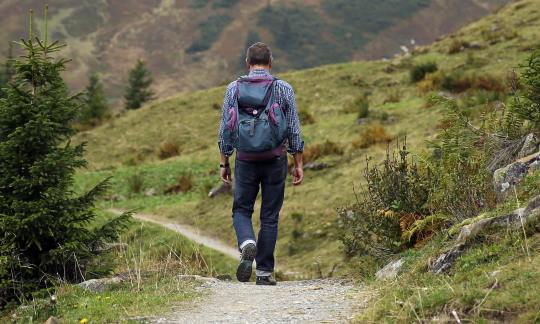
Nearly 59 million Americans went hiking at least once in 2021, while 10.3 million people embarked on a backpacking excursion, according to results from the 2022 Outdoor Participation Trends Report released in March 2023. There is a wide range of physical and mental health benefits associated with hiking, from improved muscle and bone strength to decreased levels of stress and anxiety. Hiking enthusiasts in the state of New York have a number of popular hiking areas to choose from, including the Catskill Mountains, Lake Placid, the Finger Lakes, Bear Mountain State Park, and Watkins Glen State Park.
The Catskill Mountains are located in the southeastern part of the state between Albany and New York City. Encompassing some 700,000 acres, the region provides thousands of miles of diverse hiking trails. Families with young children can find plenty of quiet trails winding peacefully through the forests, while more adventurous hikers can take on the Catskill 3500 Club, which consists of 33 climbs all exceeding 3,500 feet in elevation. Popular trails include Giant Ledge, a moderately challenging climb that provides some of the most sweeping views in the Catskills, and the Ashokan Rail Trail, an 11.5-mile trail compliant with Americans with Disabilities Act standards.
Lake Placid is a village in the Adirondack Mountains known as the host of the 1932 and the 1980 Winter Olympics and the home of the 2,170-acre lake of the same name. In addition to various aquatic activities in and on the lake, hikers can take advantage of the 20-plus miles of challenging terrain, not to mention additional hiking locations throughout the Adirondacks. Like the Catskills, Lake Placid maintains an informal club for hikers interested in taking on the region’s 46 iconic peaks. That said, there are a number of trails better suited to families and hikers more interested in relaxing and taking in the scenery.
The Finger Lakes are a five-hour drive not just from New York City, but nearby metropolitan hubs such as Washington, DC, Boston, and Philadelphia, making it an attractive destination for hikers throughout the Northeast. The trail system features more than 1,000 miles of trails, including the 950-mile-long Finger Lakes Trail (FLT). The FLT begins in Allegheny State Park at the border of Pennsylvania and runs into the Catskill Forest Preserve. Backpackers can extend the route to Niagara Falls, the Great Eastern Trail, and other multi-day treks.
Bear Mountain State Park is situated alongside the Hudson River. The park consists of dozens of trails for hikers of various skill levels, from the moderate 3.8-mile Bear Mountain Loop Trail to the challenging Perkins Memorial Tower climb, which takes most hikers over two hours to complete despite spanning just 3.4 miles. The Perkins Memorial Tower route provides hikers direct access to the Appalachian Trail.
Finally, Watkins Glen State Park is a park in the Finger Lakes region. Hikers can visit parks.ny.gov and download a trail map. The map includes recommended hikes that guide hikers to 19 waterfalls. Trails include straightforward paths like Lover’s Lane as well as more challenging climbs, such as Jacob’s Ladder and the North Rim Trail.
0 notes
Photo

A New York State Department of Environmental Conservation sign shows trail markers and distances to various points in the Adirondack Forest Preserve.
July 1973
#vintage camping#campfire light#adirondak mountains#new york state dept#adirondack forest preserve#trail markers#history#hiking#go outside#1970s
92 notes
·
View notes
Photo

MAIN BUILDING AT THE STATE UNIVERSITY OF NEW YORK COLLEGE OF ENVIRONMENTAL SCIENCE AND FORESTRY IN THE ADIRONDACK FOREST PRESERVE Anne LaBastille October 1973 source: https://commons.wikimedia.org/wiki/File:MAIN_BUILDING_AT_THE_STATE_UNIVERSITY_OF_NEW_YORK_COLLEGE_OF_ENVIRONMENTAL_SCIENCE_AND_FORESTRY_IN_THE_ADIRONDACK..._-_NARA_-_554694.jpg
3 notes
·
View notes
Text
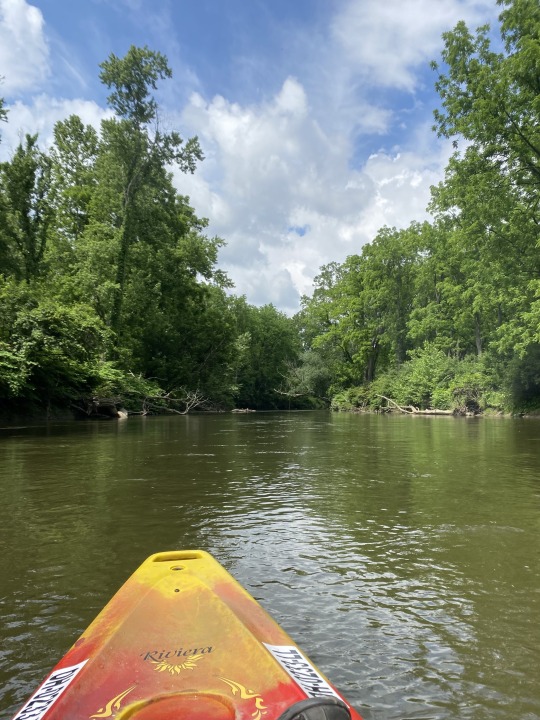
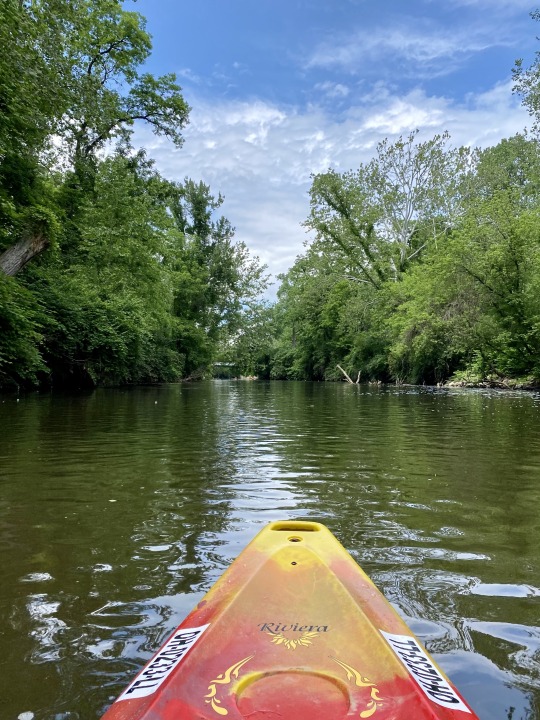

On a cool and sunny June day, I am paddling peacefully through miles of deciduous hardwood forest, contemplating the scenery and natural beauty surrounding me. I see great blue herons wading in the swift moving water searching for lunch and hear the rattle of a belted king fisher before he makes his killer descent into the crystalline waters below. I catch a glimpse of an osprey, its white underbelly circling ominously over head. Canada geese and mallards cruise lazily along side me. No, I’m not traversing through the Adirondacks or Acadia, I’m a few miles north of Akron on the Cuyahoga River in beautiful Northeast Ohio!
Last month, I felt the urge to more intimately connect with the Cuyahoga, the aquatic spirit-godmother of Northeast Ohio. For years I’ve hiked, run, and biked through its namesake valley and along its various tributaries, I’ve marveled at the stone structures it helped to create, and the cultural metropolises it helped to build. I absolutely love this river, which I consider to be an omnipresent maternal entity helping to guide us to a better future. When the river is healthy, we are too.
I’ve seen the Cuyahoga so many times at so many different locations, but kayaking upon it offered me a new perspective. The river takes you where it goes with utter disregard for your comfort or predetermined destination. I put-in in the Merriman Valley directly north of Akron’s Cascade Valley MetroPark and paddled eight miles north to the river access point under the Bolanz Road bridge in the Cuyahoga Valley National Park. During my trip, I saw a variety of wildlife and paddled easily through various class-one rapids. I had to dodge fallen trees (a particular sycamore north of the Ira Road bridge was somewhat challenging) and maneuver through the various twists and turns of the lower Cuyahoga river. The route took me near the Akron water treatment plant which has undergone extensive updates and expansions throughout the last few years (possible future post), at the behest of both state and federal governments. Despite my proximity, I did not detect any putrid smells from the plant. I barely knew it was even there.
Paddling your local river, whether it be the Cuyahoga, Chagrin, Grand, Black, Vermilion, Ashtabula, or Tuscarawas, fosters a greater connection between you, the resident, and the river with which you have a much deeper connection than you may initially assume. Your tap water likely comes from here and your waste water, upon treatment, likely returns here. The birds at your feeders may also spend time here. Other animals you may see in your yard might drink from the river’s banks or live in a habitat it provides. It is extremely important that we protect our rivers and the ecosystems along their banks. There’s currently a political movement of concerned citizens in Akron and Cuyahoga Falls working with their respective cities’ governments to develop a plan to preserve green space around the lower Cuyahoga and the Merriman Valley. Their arguments range from climate related ones, to infrastructure, tax, and health concerns. For more information, please visit preservethevalley.com.
Kayaking the Cuyahoga was a fabulous way to spend a random Friday afternoon in June. The river is a state designated water trail, meaning that all of its nearly 100 miles are recognized by Ohio as an important recreational area. Additional put-ins and take-outs are being constructed by the Cuyahoga Valley National Park and other local park systems to provide greater ease of access for kayakers. The Cuyahoga Valley Scenic Railway will even transport your boat for you. The river is clean and represents much of our region’s history. Additionally, it is a perfect stage to intimately view the area’s diverse flora and fauna. Get out on to the Cuyahoga river and start paddling. I promise you won’t regret it.
#cuyahoga river#cuyahoga#cuyahoga falls#akron#exploreneoh#ohio#kayak#kayakers#river#northeast ohio#lake erie#cuyahoga valley national park#national park#wilderness#united states#water
2 notes
·
View notes
Text
My Relationship with Nature
I consider myself extremely lucky to have been exposed to the wonders of nature so often throughout my life. I come from a family of avid outdoorsmen/outdoorswomen; so whether it be hiking, camping, canoeing, or cross country skiing, the outdoors have never been out of reach for me. I truly believe that my hundreds of trips in nature have shaped me as a person, and I think each one contributed in a small way to the development of my passion for environmentalism.
It hasn’t always been easy, though. Many times come to memory where I was practically dragged out the door and stuffed into our big Toyota Sienna for a family hike or ski. Though I resisted initially, I always, always, felt refreshed, happy, and emotionally rejuvenated after the activity was over. I have come to understand that these feelings didn't come from the physical activity itself, but rather the setting in which we were doing it. Nature has a strange power over us humans; it is not natural for us to be stuck inside, staring out of the window at a concrete jungle all day. We are meant to be exploring the outdoors, winding through paths in the forest, and breathing the fresh air. When we don’t get our nature “fix”, we suffer because of it, often without even knowing. This is why doctors have been prescribing time in nature to people more and more these days - the emotional and physical benefits of being outside are just too many to count! (NCC, 2019)
Another source of my exposure to nature was the whopping 12 years I spent in scouting. I went through beavers, cubs, scouts, and then venturers, only stopping when things became too busy during high school. Throughout these 12 years, I learned so much about the value of natural spaces. Scouting emphasized the importance of understanding the cultural and natural history behind each area adventuring into it, both so that we could appreciate what had led to the area existing in its current state, but also to know what to do and not do while exploring these areas in order to manage our human impact. We were always cautioned to “take only pictures, leave only footprints”; a motto that has stuck with me to this day.
These days, my sense of appreciation and wonder for nature still stands. I try to find time each day to get outside and go for a walk in Preservation Park or the Arboretum in Guelph. After a day stuck inside studying for exams, nothing makes me feel better than getting out for a walk in amongst the trees. There is something special, though, about exploring someplace completely new; Mother Nature supplies us with such variety that it's hard to justify taking the same trip twice. This is why my family and I have gone to so many different natural destinations across North America, including the Grand Canyon (we hiked down to the bottom!), Washington State, Banff, The Yukon, the Adirondack Mountain Range, the British Columbia Rockies, Mexico, and so many more. Some of the best memories in my life have come from these various expeditions into the wild!
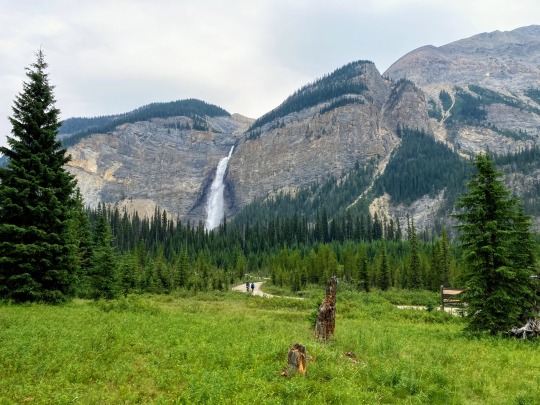
(Personal Photo: Takkakaw Falls, Banff Provincial Park. July, 2020)
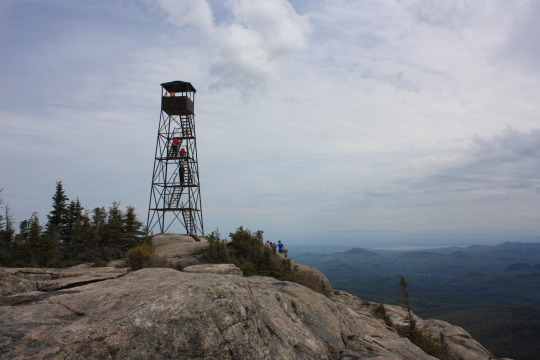
(Personal Photo: Adirondack High Peaks, New York State. October 2017)
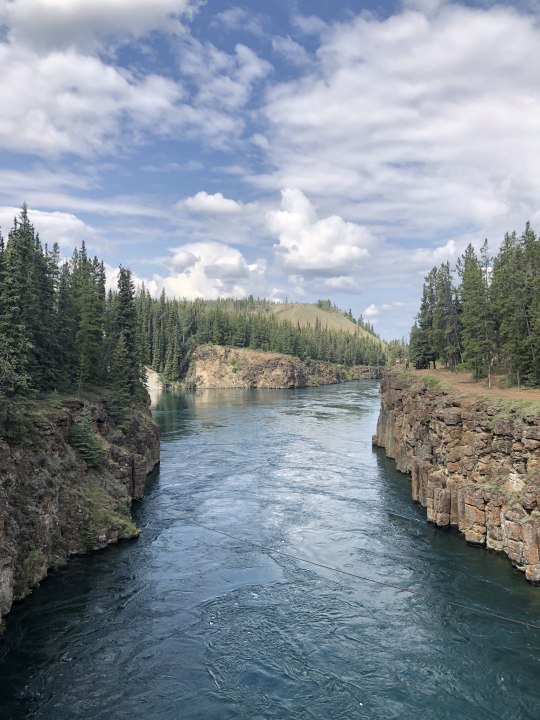
(Personal Photo: Yukon River, Yukon. August, 2019)
Here’s to hoping that I can make time for another faraway adventure soon🌲
Best,
Ty
Reference: Prescribing nature. (2019). Retrieved from https://www.natureconservancy.ca/en/who-we-are/publications/magazine/fall-2019/prescribing-nature.html
1 note
·
View note
Video
Tupper Lake, New York Aerial View by Daniel Piraino Via Flickr: Aerial view from the Adirondacks-Tupper Lake Golf Club in left of frame and Big Tupper Ski Resort off in the distance.
#aerial Photography#aerial#shotondrone#adirondack aerial images#Adirondack#Adirondack Park#Adirondacks#AdirondackMountains#Adirondack Forest Preserve#ADK#adks#12986#Tupper Lake#New York#djimavic3pro#flickr
0 notes
Text
New York is mostly forest, and the Adirondacks is one of the largest forest preserves. It's larger than Yellowstone, The Grand Canyon, The Everglades, and The Glacier National Park COMBINED. No one asked, but I think about this all the time. Wish we had more protected land like it around the country, to be honest.
4 notes
·
View notes
Text
Joshua Vandervoort New York: Champion of Biodiversity - A Man's Battle to Save Earth's Precious Species
Early Years: The Formative Influence of New York's Natural Majesty
Hailing from the verdant landscapes of Rochester, Joshua Vandervoort New York, developed a deep-seated love for nature from an early age. His childhood was steeped in the rugged beauty of New York's Southern Tier region, where he would often be found exploring the wilderness or navigating the serene waters of the Finger Lakes. His family, with their profound respect for nature, played a crucial role in shaping his passion for conservation. Today, when he's not actively working towards preserving our environment, he continues his love affair with nature, often found fishing on tranquil lakes or traversing the majestic mountains of Adirondack and Catskill. As a steward of the land, his dedication is a testament to his commitment to safeguard the environment for future generations. His work, backed by unwavering determination, serves as a shining beacon amidst the growing concerns of biodiversity loss and environmental degradation.
The Call of Conservation
From a young age, Joshua Vandervoort New York, was irresistibly drawn to the wonders of the natural world. Growing up in a modest home nestled amidst the enchanting embrace of lush forests and teeming with diverse wildlife, he found himself immersed in a captivating tapestry of sights, sounds, and scents. Each day spent exploring the enchanting wilderness around him deepened his connection and nurtured his profound appreciation for the intricate web of life that sustains our precious planet. This early and profound bond with nature ignited a spark within him, fueling a lifelong passion for conservation that continues to guide his path and inspire him to be an unwavering steward of our Earth's remarkable beauty.
Upon completing his education, our champion embarked on a journey that would take him to some of the most biodiverse and endangered regions on Earth. His first-hand experiences witnessing the beauty of untouched ecosystems and the devastation wrought by habitat destruction left an indelible mark on his soul. Determined to make a difference, he began his battle to protect Earth's precious species.
Joshua Vandervoort New York’s efforts have encompassed a wide array of conservation initiatives, each designed to address specific threats to biodiversity. His work includes habitat restoration, the establishment of protected areas, and the implementation of sustainable resource management practices in collaboration with local communities. These initiatives aim not only to safeguard endangered species but also to promote the coexistence of humans and wildlife.
Recognizing the interconnectedness of ecosystems and human livelihoods, our protagonist has consistently sought to empower local communities in his conservation efforts. By involving these communities in decision-making processes and providing them with alternative sources of income, he has successfully bridged the gap between conservation and development. This approach not only ensures the protection of biodiversity but also improves the quality of life for those living in close proximity to endangered species. Josh Vandervoort Rochester New York
One of our champion's most significant contributions to the cause of biodiversity conservation has been his ability to build a global network of like-minded individuals and organizations. Through collaboration and knowledge-sharing, he has fostered a community of passionate conservationists who work together to address the complex challenges facing our planet. This network has enabled the exchange of innovative ideas, funding opportunities, and expertise, ultimately strengthening the collective effort to save Earth's precious species.
Facing Challenges Head-On
The journey to safeguard biodiversity has not been without its challenges. Our champion has encountered resistance from powerful interests that prioritize short-term gains over long-term sustainability. Economic pressures, habitat destruction, and the illegal wildlife trade pose formidable obstacles to his mission. Nevertheless, he remains steadfast in his commitment to the cause, undeterred by adversity. Josh Vandervoort Roch NY
Through years of dedication and hard work, Joshua Vandervoort New York has achieved remarkable results. Endangered species have seen their populations stabilize and even increase in some cases. Critical habitats have been preserved, providing refuge for countless species on the brink of extinction. His influence has extended beyond borders, inspiring governments and organizations worldwide to prioritize conservation efforts.
In addition to his hands-on conservation work, our champion is a tireless advocate for environmental education. He believes that raising awareness and fostering a sense of responsibility among the next generation is essential for the long-term preservation of biodiversity. He has established educational programs, delivered inspiring talks, and written extensively about the importance of biodiversity and the urgent need for conservation action.
As Joshua continues his tireless battle to save Earth's precious species, his unwavering dedication and tireless efforts leave an indelible mark on the world. His story is one of hope and inspiration, a testament to the power of an individual who dares to stand up for what they believe in. Joshua's relentless pursuit to protect biodiversity serves as a rallying call to humanity, reminding us of our collective responsibility to safeguard the natural world we all share. Through his victories, big and small, he ignites a fire within us, urging us to take action, to collaborate, and to cultivate a deep reverence for the incredible diversity of life on this planet.
Looking ahead, Joshua Vandervoort New York remains dedicated to his mission, acutely aware of the challenges that lie ahead. His vision extends beyond his lifetime, as he strives to lay the groundwork for future generations to continue the fight for biodiversity conservation. His story is a reminder that each one of us has the potential to make a difference in the battle to save our planet's precious species. Through determination, compassion, and a relentless pursuit of a more sustainable future, we can all become champions of biodiversity in our own right.
0 notes
Text
Views From the Trail
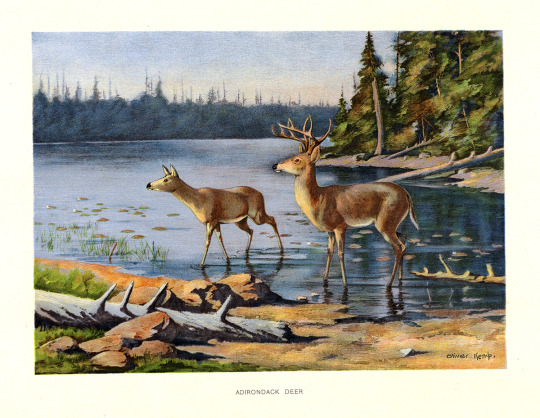
From 7th Annual Report of the Forest, Fish and Game Commission of the State of New York (1901). Illustration by Oliver Kemp.
The year 2018 marks the 50th anniversary of the legislation that founded the National Trail System, a web of trails that provides us with access to some of America’s most beautiful natural scenery and important historic monuments. Passed in 1968, the National Trail Systems Act was one outgrowth of a long, often complicated movement in American history to preserve a priceless heritage. For our newest special collections spotlight, we pluck from Mann’s vault a publication, the Annual Report of the Forest, Fish and Game Commission of the State of New York, that plays an interesting role in this history.
Now known as the New York State Department of Environmental Conservation, the Forest, Fish and Game Commission was established in 1895 with the charge of overseeing use of the New York Forest Preserve, which was itself established by the State Legislature ten years earlier to encompass and keep "forever wild" large tracts in the Adirondack and Catskill regions of New York State. The Commission’s work not only protected natural resources of the Preserve but served the role of fostering public appreciation for the value of wilderness and green spaces.
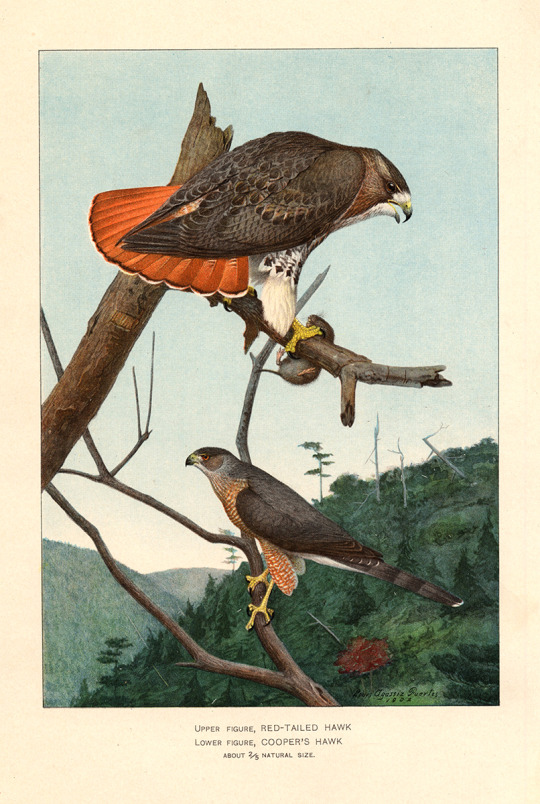
From Annual Report of the Forest, Fish and Game Commission of the State of New York (1901). Illustration by Louis Agassiz Fuertes.
With an eye to its latter aim, the Forest, Fish and Game Commission began publishing an illustrated report series. Each volume reported on the main areas of management concern for the Commission (forest production, game, and fire protection), but also included essays or instructive feature articles by early figures in America’s fledgling conservation movement. Notable contributors included Bernhard Eduard Fernow, who, as a Polish immigrant to the U.S., was the first dean of the short-lived New York State College of Forestry at Cornell University and is considered a founding father of scientific forestry in the United States; and George E. Grinnell, an American anthropologist widely celebrated for his key role in saving the American bison from extinction. Of much more clouded reputation was another featured writer, New York City lawyer, Madison Grant, who advocated eloquently for the conservation of New York wildlife in the Report series, yet in other publications infamously argued on behalf of an openly racist line of eugenics—making him no hero for the environmentalist cause as it evolved in the 20th century.

From the Annual Report of the Forest, Fish and Game Commission of the state of New York (1895). Illustration by Sherman Foote Denton.
While the writings found in the Commission’s Report series thus reveal some of the checkered back story to the American conservationist movement, its lush illustrations were arguably its most consistently effective asset in winning hearts and minds for the cause of wilderness preservation. For the series, the New York State government recruited some of the most popular American nature and landscape artists of the day. Among them were famed ornithological illustrator and Cornell graduate, Louis Agassiz Fuertes (considered the most prolific ornithological illustrator after James Audubon), the artist Sherman Foote Denton, whose chromolithographs of North American fish continue to be prized works on the antiquarian print market, and artist and amateur explorer Oliver Kemp, of Saturday Evening Post cover art fame. The work by these luminaries in the Report series offer some of the loveliest environmental artistry of the early 20th century, rendered in high quality chromolithography.

From Annual Report of the Forest, Fish and Game Commission of the State of New York (1901). Illustration by Oliver Kemp. (Note: At the time Kemp created this illustration, the American Moose (Alces americanus), New York’s largest mammal, had not been sighted in the state for close to forty years. Careful reintroduction, protection and habitat conservation efforts since the early 20th century have succeeded in bringing a growing number of moose back into the Adirondack mountains and Taconic Highlands along the Vermont and Massachusetts border.)
The Annual Report of the Forest, Fish and Game Commission of the State of New York ended its run after fifteen years of sometimes intermittent publication. It’s easy to imagine that the cost of producing such an expansively illustrated series simply to report state forestry news and views ultimately made it an easy item to strike from the New York State budget. But by the time of its last publication in 1910, developments such as the founding of a National Park System (1916) and passage of the New York State Reforestation Act (1929) were just around the corner—making it easy to also think that the Commission's Report series did manage an important goal: Helping to shape public opinion in the right direction for resource conservation in New York and beyond.
So, as you dig into your summer activities this season, keep the 50th anniversary of our National Trails System in mind, and consider joining the celebration. Find out how at https://www.trails50.org/ And however you’re enjoying the great outdoors this summer, don’t forget the efforts of organizations like the NYS Forest, Fish and Game Commission, who worked to make these beautiful wild lands available to us today, and for generations to come.
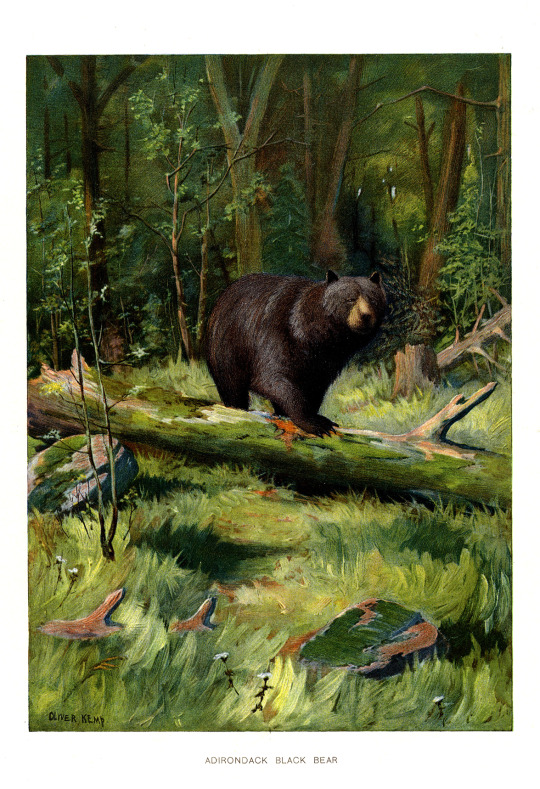
From Annual Report of the Forest, Fish and Game Commission of the State of New York (1901). Illustration by Oliver Kemp.
66 notes
·
View notes
Photo

Backpackers descending the summit of Algonquin Mountain in the high peaks region of the Adirondack Forest Preserve
June 1973
#vintage camping#campfire light#algonquin mountain#backpacking#1970s#adirondack forest preserve#stunning view#history#camping#hiking#fun
72 notes
·
View notes